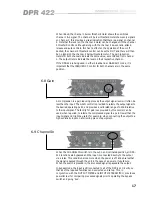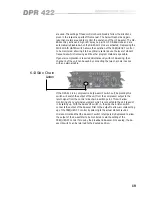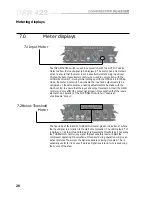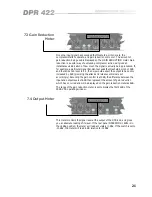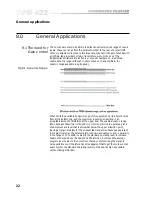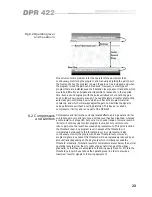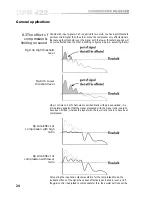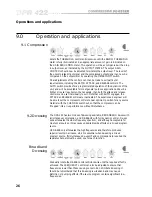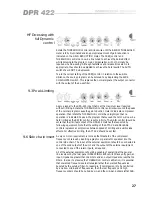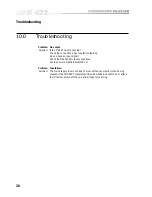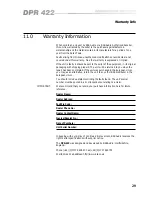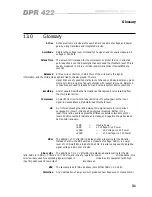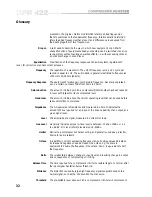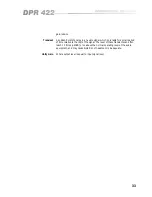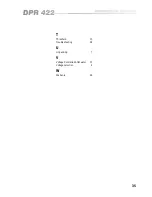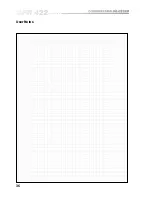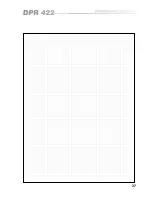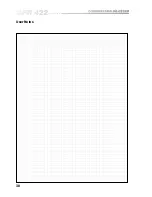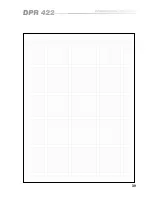
25
increased. The net effect, therefore, is for both ends of the dynamic spectrum to
be pushed (or squeezed) towards each other. This squeezing effect of
compression is important to remember, and provides a major difference
between compression and limiting. I.e. Limiters do not make-up the gain
reduction.
The range provided by the DPR 422 on its
ratio
and
release
controls is
sufficient to allow its use either as a compressor or limiter. For limiter
applications, the
release fast
switch should generally be
out
.
A common problem encountered when amplifying the human voice is the
large amount of High Frequency energy, heard as the sibilant ‘sss’ sound.
These high frequency or sibilant sounds can reach levels considerably greater
than the normal voice level, and will result in signal break-up or distortion. It is
possible to control these sounds independently of the normal program by
making a normal compressor sensitive only to these high frequencies. Selective
high frequency compression is generally called de- essing, as it removes the
‘sss’ content from the program. The DPR-422 can provides this capability in
either of two distinct ways, BROADBAND de- essing and HF DE-ESSING.
8.4 De-essing
As set by the DE-ESS control with the DE-ESS HF switch OUT, once the DPR-
422 detects excessive amounts of signal above the frequency set by the
FREQUENCY control, it will start to gain reduce the program level. As this
reduction occurs over the whole frequency range of the program, it is called
broadband de-essing. Remember though that no reduction occurs unless the
DPR-422 encounters a high frequency signal, and that in broadband mode, the
main compressor is not utilised and remains available.
8.5 Broadband
De-essing
Selected by depressing the DE-ESS HF button, this provides an extension to
broadband de-essing by only compressing signals with a frequency above that
set by the FREQUENCY control. Signals with frequencies below that set by the
FREQUENCY control are unaltered. HF DE-ESS mode may be considered to
function rather like a dynamic HF filter.
The type of de-essing to be used in a particular situation will depend largely on
the program type, and whether the input to the DPR-422 is a mix of sibilant
sounds and other program material, or exclusively the sibilant sound, for
example a vocalist. HF only de-essing will generally be used when processing
a mix of program, whereas broadband de-essing will be acceptable when
processing only the sibilant sound.
It should be realised that de-essing is very different from simple equalisation,
since equalising a sibilant vocal by cutting high frequencies would result in
loss of high frequency content at all times. De-essing has no effect whatsoever
on the signal, except at the moment of sibilance, and then the effect is only of
overall level change. There is no change in the general frequency response, yet
sibilance is controlled.
8.6 HF De-essing
Summary of Contents for DPR 422
Page 1: ...1 DPR 422 User Manual...
Page 8: ...8 The DPR 422 Fig 4 2 Rear Panel Fig 4 1 Front Panel...
Page 9: ...9 All numbers in bubbles refer to Section numbers...
Page 36: ...36 User Notes...
Page 37: ...37...
Page 38: ...38 User Notes...
Page 39: ...39...
Page 40: ...40 User Notes...







